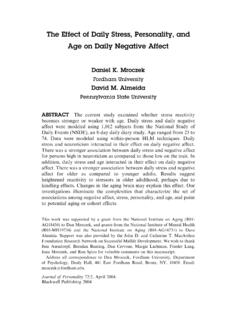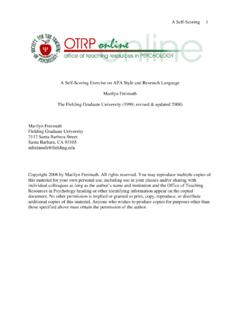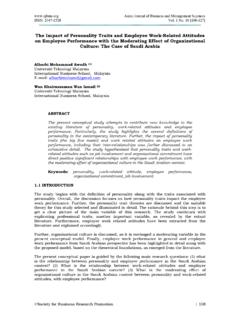Transcription of Coping Strategies to Confront Problems and Work Stress ...
1 (2016).2(9):38-4638 International Journal of Current Research inMedical SciencesISSN: 2,Issue9-2016 OriginalResearch ArticleCoping Strategies to Confront Problems and Work Stress amongHealth Practitioners According to Their personality TypeNora Yonis Alsomali1,*Ahmed Abdella Mohammed Osman2,Khalid Mohammed in Public Administration, BSc in Hospital Administration, BSc in Radiological Professor of Community Medicine at Faculty of Public Health & Health Informatics,Umm Al-Qurra University, of Public Health, Health Affairs, Jeddah, KSA.*Corresponding author:Ahmed OsmanFaculty of Public Health & Health Informatics, Umm Al-Qurra University, : 00966544941248,Fax: Stress and burnout are considered as main Problems affect employees health and the Coping strategiesareoriented either towards the problem or to the emotion.
2 And there is an association between burnout and Strategies are related to burnout, in favor of positive influences the types ofcoping Strategies that used by the aim of this study is to identify the level of using Coping strategiestoconfront Problems and work Stress among thehealth practitioners, according to their personality is thedescriptive cross sectional study targeted the Health Care Providers and using personality type (A and B)scaleandstress- Coping Strategies scale on burnout. This study revealed that most of the study sample was having personalitytype (A), and the respondents used Coping Strategies in various ways and degrees.
3 The health practitionershavingpersonality type (A) were with low Coping forces and they used positive and negative Coping Strategies frequentlymorethan health practitioners having type (B) :Burn-out; Coping Strategies ; Health Practitioners; personality organizations develop a new contextin line with the new technological, economic andsocial changesthat lead to a series ofpsychosocial Problems that contribute to jobstress and burnout which are considered as mainproblems affect employees health (Jawahar et al.,2007). Economically, the organizations payannually more than 60 billion dollars on work- Stress related diseases (Matteson & John 1987).
4 Health occupations considered as oneof the moststressful jobs and health practitioners suffer fromfatigue and pressures besides experiencing highdegrees of depression and anxiety. Anxiety andstress experienced by nurses and doctors arecreated by many factors (personal or impersonal)such as: Stress caused by patients and theirrelatives increasing working hours of night anddaytime (Vahey, et al., 2004).DOI: (2016).2(9):38-4639 BurnoutIt is a syndrome of exhaustion, cynicism and lowprofessional efficacy (Maslach et al., 1996).Another definition broughtby Corey et al.
5 (2007)as a state of physical, emotional, intellectual andspiritual exhaustion that manifests itself asfeelings of helplessness or hopelessness . Thereare many factors affecting burnout like socialsupport (I. Kim, 2012; Kim &Jeong, 2012), self-efficacy (Cho & Park, 2007; Lim & Kim, 2011),ego-resilience (Kim &Sunwoo, 2012; I. Kim,2012), feelings of subjective well-being (J. Lee,2010) and Stress Coping Strategies (Kim &Sunwoo, 2012; Montero-Marin, Prado-Abril,Demarzo, Gascon, &Garc a-Campayo, 2014). So,unmanaged Stress is known leading cause ofburnout and other psychological Problems (Coreyet al.)
6 , 2007). Coping StrategyIt means any behavior that helps us to exert betterinteraction in a given situation. It referred to thespecific efforts, either behavioral or psychologicalor both which people obtain to tolerate, control,reduce, or minimize stressful events. Lazarus andFolkman (1986) defined Coping as thosechanging cognitive and behavioral effortsdeveloped for managingthe specific externaland/or internal demands judged as exceeding orsurpassing the individual s own resources .Generally, there are three methods of copingstrategies: active-behavioral,active-cognitive, andavoidance (Billings & Moos 1981).
7 Andregarding the objectives of the Coping Strategies ,it can be oriented towards the problem or orientedto the emotion (Lazarus &Folkman, 1986;Edwards, 1988; Begley, 1998). It seems that thecoping Strategies that oriented to the problemexert more benefits thanstrategies oriented to theemotion or avoidance (Roger, Jarvis &Najarian,1993; Hart et al., 1995), and it would be moreeffective when the potential stresses of theenvironment are well controlled (Folkman, 1984;Edwards, 1988;Dewe, 1987; Labrador, 1995;Peir & Salvador, 1993; Long, 1998; Ito &Brotheridge, 200; Pe acoba, et al.)
8 , 2000).Thornton (1992) found that there is an associationbetweenavoidanceascopingstrat egiesandburnout. And the burnout makes the organizationsto lose significant resources in terms of patientsatisfaction, decreased work quality andprofessional development of staff and turnover, aswell as absenteeism and job exit (Cordes andDougherty 1993; Maslach and Jackson 1981;Ozer and Beycioglu 2010; Vahey et al. 2004).StressGandi et al. (2011) defined Stress as anindividual s response to a perceived imbalancebetween situational demands and one s copingresources . Decker and Borgen (1993) definedoccupational Stress as the strain experiencedwhen an individual sperceived workplace stressexceeds Coping skills and typically it comesfrom inappropriate work environment andemployment conditions (Wu et al.
9 , 2007).Obviously, there is an association betweenburnout and occupational Stress in manyprofessions likepsychology, nursing, medicine,teaching and social work (Johnson and Stone1987; Rupert & Morgan 2005; Vercambre et al.,2009; Wang et al., 2014; Xie et al., 2011). On theother hand, there are some individual factorscontributing to burnout like inadequate supportstaff and autonomy, low social support,ineffective Coping Strategies , clinical setting, ageof the employee and heavy workload (Dexter etal., 2003).Kalichman, (2000) revealed that nurses whoexperienced work Stress are using copingstrategies to fight against stresses and they usesuch Strategies : acceptance, positive appraisal andwishful thinking more Strategies are related to burnout, in favorof positive Strategies like planning, restraintcoping and non-denial (Dorz et al.
10 , 2003) whilenegative Coping Strategies like avoidance, denialor inactive/passive are mainly with low uses(Slagle, 1996; Leiter&Harvie, 1996; Cushway&Tyler, 1994; Koeske, Kirk, &Koeske, 1993;Thorton, 1992). Using of Coping Strategies iscorrelated with the level of burnout, also, copingstrategies observed to be as a protective factorfrom burnout among the nurses (Gueritault-Chalvin et al., 2000). (2016).2(9):38-4640 Regarding the personality types , Carver&Scheiver (2000) mentioned that the personalitytypes are distinguishing characteristics or qualitiesto prepare the individual to think, act and torespond to a wide range of different situations orstimuli similarly.









